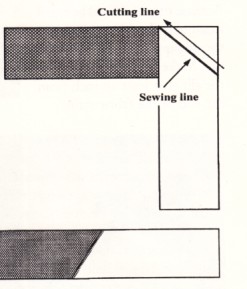I get lots of questions about the ways that rug strips are joined together, so to save everyone time here is a primer on the types of joining methods. There are three general groups of methods of joining fabric strips: sewn, friction (unsewn), and knotted joints.
SEWN JOINTS
The Bias Joint

Anyone who has read any of my books knows that this is the method I always recommend. The bias joint makes a smooth joining, without creating a lump where the seam is. It is quickly done ahead of time on a sewing machine for those types of rugs which use long continuous strips, but I also use it for rugs which are made from short strips of fabric -- even if I have to sew by hand.
It is by far the best and most reliable joint. To make a bias joint, place two strips at 90-degrees with right sides together. The ends of the strips form a corner. Stitch across the corner. Clip the excess off about ¼ inch from the seam. When the strips are unfolded, you will see that the seam runs diagonally to the strips.
The "Straight" Seam
This joint was often used with rugs made from old stockings, since there wasn't a lot of bulk in the material. Two strip ends are laid one over the other, with right sides together, and a seam is sewn straight along the ends, with about ¼ inch seam allowance. When unfolded, the seam runs straight across the strips.
Tacked Joints
Tacked joints were most often used in preparing rag strip for weaving, but also for other methods such as crocheting or knitting where appearance wasn't a big factor. Strips of fabric are handled end-to-end, overlapping one to the next about ½ inch. In the center of the overlap, the strips were sewn together, either tacking with a few stitches by hand or with a sewing machine.
FRICTION JOINTS:
Overlaid Joints
These are also worked with overlapping ends of strips, except that there is no sewing involved. As the end of one strip is near, the next strip is simply overlapped for about six inches. Through the overlap, the two strips are handled as a single strip. This joining was used with loom weaving, crocheting and some braids to avoid sewing. There will be tag ends of the strips that stick out and have to be clipped off, and it is important when using this joint that the work is done tightly so that the strip ends cannot work loose since it is only the friction between the two strip ends which holds the joinings together.
KNOTTED JOINTS
Slit and Loop Joints
This is a quick knotted joint, but does show in the rug but can result in a lumpy rug and makes for an uneven texture. It is used only for woven fabrics. Cut a slit lengthwise, about ½ inch from the end of the first strip. The slit should only be large enough to allow the bulk of the next strip to pass through it. Cut a similar slit about ½ inch from the end of the second strip. Bring the UNCUT end of the second strip through the slit of the first strip, and then through the slit in the second strip. Pull the strip snugly to tighten the knot.
There are at least seven other slit and loop joints that have been used for rugs, but the only one I recommend for rug applications is the "bow tie" joint which allows the strips to lay flat against each other.
Chain Joints
If you've ever made a chain of rubber bands, you know how to make this joint. It does create knots in the rug, but depending on the softness of the materials used, they need not be too prominent. This joint is only used for fabrics which come in a loop, such as socks or stockings cut horizontally across, T-shirts cut horizontally or Girdle rugs (see Novelty and Fad Rugs). To make a chain joint, take two loops of fabric. Pass the end of one through the opening of the other. Then pass that same end through its other end. Make sure as you chain loops together that the sides of the chained loops are even so that the strip will lie straight.
Tied Joints
With light fabrics, the ends of the strips were sometimes tied using either a square knot or an overhand knot. The ends of the strip could be cut close to the knot or left long to create a shaggy surface. The knots are however prominent in the rug, so this joining was most often used for utilitarian applications like scuff mats. Avoid tied joints if you possibly can, they really should be the last choice.